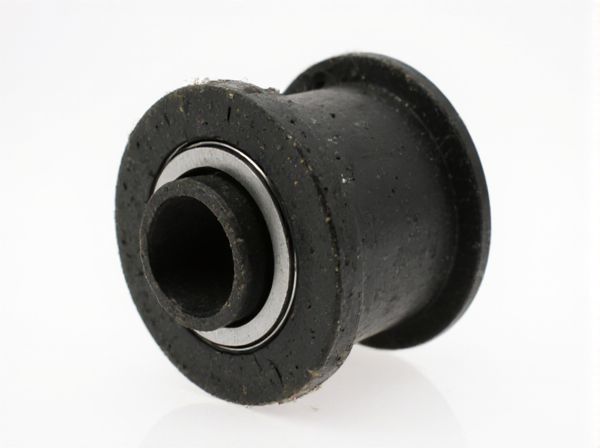
Photo illustration: Spherical Bearing vs Rubber Bushing
Spherical bearings offer precise rotational movement and superior load handling in automotive and industrial applications, providing longer-lasting performance under heavy stress. Rubber bushings, on the other hand, excel in vibration dampening and noise reduction, making them ideal for comfort and flexibility in suspension systems. Choosing the right component depends on Your specific needs for durability, noise control, and mechanical flexibility.
Table of Comparison
| Feature | Spherical Bearing | Rubber Bushing |
|---|---|---|
| Material | Hardened Steel with PTFE Liner | Rubber Compound |
| Flexibility | Low - Precise Motion Control | High - Absorbs Vibrations |
| Durability | High - Resistant to Wear | Moderate - Subject to Degradation |
| Noise & Vibration | Higher Noise Transmission | Reduces Noise and Vibration |
| Maintenance | Requires Regular Lubrication | Low Maintenance |
| Performance | Improved Handling and Precision | Comfort Focused Suspension |
| Cost | Higher Initial Cost | Lower Cost |
| Best Use | Performance Vehicles and Racing | Daily Driving and Comfort |
Introduction to Spherical Bearings and Rubber Bushings
Spherical bearings are designed to accommodate rotational and angular misalignment between connected components, featuring an inner ring with a convex spherical outer surface that moves within a concave outer ring. Rubber bushings function as flexible isolators, absorbing vibrations and reducing noise by providing a cushioning interface between mechanical parts, often used in automotive suspension systems. Both components are essential for enhancing durability and performance in dynamic mechanical assemblies by managing motion and reducing wear.
Key Differences Between Spherical Bearings and Rubber Bushings
Spherical bearings provide precise rotational movement and high load capacity by utilizing a hard inner ring and a smooth outer surface, ideal for applications requiring angular misalignment accommodation. Rubber bushings offer vibration isolation and flexibility through their elastomeric material, reducing noise and absorbing shocks in suspension systems. Key differences center on durability and performance: spherical bearings excel in handling dynamic loads and alignment changes, while rubber bushings prioritize cushioning and noise reduction.
Construction and Design Features
Spherical bearings feature a steel inner ring with a convex outer surface encased in a metal housing, allowing rotational movement and angular misalignment, making them suitable for heavy-duty applications. Rubber bushings consist of an elastomeric component bonded to a metal inner and outer sleeve, providing vibration dampening and flexibility while limiting movement to reduce noise and wear. The rigid metal and articulating design of spherical bearings offer enhanced precision and load capacity compared to the compliant, cushioning nature of rubber bushings commonly used in suspension systems.
Material Composition and Durability
Spherical bearings are typically made from hardened steel with a polished chrome steel or stainless steel inner ring, offering superior load capacity and precise articulation in dynamic applications. Rubber bushings consist of layered rubber compounds bonded to a metal sleeve, providing excellent vibration dampening and flexibility but lower resistance to wear under heavy loads. The durability of spherical bearings surpasses rubber bushings in high-stress environments due to their metal construction, while rubber bushings excel in absorbing shocks and reducing noise in less demanding conditions.
Performance in Vibration and Noise Reduction
Spherical bearings provide superior vibration isolation and noise reduction under high load and dynamic conditions due to their ability to accommodate angular misalignment and maintain structural integrity. Rubber bushings excel in dampening high-frequency vibrations and reducing noise through elastic deformation but may degrade faster under heavy loads and extreme temperatures. Choosing between spherical bearings and rubber bushings depends on the application's load requirements, vibration frequency spectrum, and environmental durability needs.
Load Handling and Flexibility
Spherical bearings excel in load handling by accommodating heavy radial and axial loads while allowing multi-directional rotation, making them ideal for applications requiring precise movement under stress. Rubber bushings provide superior flexibility and vibration damping, absorbing shocks and reducing noise, but they have limited load carrying capacity compared to spherical bearings. Choosing between the two depends on balancing the need for robust load support with desired flexibility and noise isolation in suspension or mechanical systems.
Maintenance Requirements and Longevity
Spherical bearings require regular lubrication and periodic inspections to prevent wear and ensure optimal performance, making their maintenance more intensive compared to rubber bushings. Rubber bushings offer lower maintenance needs due to their self-lubricating properties but tend to degrade faster under extreme temperatures and heavy loads, reducing their longevity. The lifespan of spherical bearings generally surpasses rubber bushings in high-stress applications, though rubber bushings excel in absorbing vibrations with minimal upkeep.
Common Applications in Automotive and Industrial Sectors
Spherical bearings are commonly used in automotive suspension systems and industrial machinery to allow rotational movement and accommodate misalignment under high load conditions. Rubber bushings, favored in vehicle chassis and engine mounts, provide vibration damping and noise reduction by absorbing shocks and isolating components. Both components play essential roles in enhancing durability and performance in automotive steering and industrial equipment with dynamic load requirements.
Cost Comparison and Budget Considerations
Spherical bearings generally have a higher upfront cost compared to rubber bushings due to their complex design and materials, making them a premium choice for precision applications. Rubber bushings offer a cost-effective solution with lower initial expenses and easier installation, suitable for budget-conscious projects requiring basic vibration isolation. When considering long-term expenses, spherical bearings may deliver better durability and performance, potentially lowering maintenance costs despite the higher initial investment.
Choosing the Right Option: Factors to Consider
Choosing between spherical bearings and rubber bushings depends on factors such as load capacity, flexibility, and operating environment. Spherical bearings excel in handling high radial and axial loads with precise rotational movement, making them ideal for heavy-duty applications and harsh conditions. Rubber bushings offer superior vibration damping and noise reduction but are best suited for low to moderate load scenarios with limited rotational movement.
 caratoz.com
caratoz.com